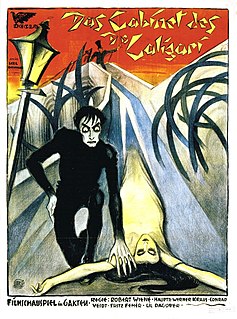
The Cabinet of Dr. Caligari is a 1920 German silent horror film, directed by Robert Wiene and written by Hans Janowitz and Carl Mayer. Considered the quintessential work of German Expressionist cinema, it tells the story of an insane hypnotist who uses a somnambulist to commit murders. The film features a dark and twisted visual style, with sharp-pointed forms, oblique and curving lines, structures and landscapes that lean and twist in unusual angles, and shadows and streaks of light painted directly onto the sets.

Dr. Caligari is a 1989 American avant-garde horror erotic film co-written and directed by Stephen Sayadian and starring Madeleine Reynal, Laura Albert, Gene Zerna, David Parry, Fox Harris and Jennifer Balgobin. It is a quasi-sequel to the 1920 film The Cabinet of Dr. Caligari. The film details a disturbed doctor and her illegal experiments on her patients.

Robert Wiene was a film director of the silent era of German cinema. He is particularly known for directing the German silent film The Cabinet of Dr. Caligari and a succession of other expressionist films. Wiene also directed a variety of other films of varying styles and genres. Following the Nazi rise to power in Germany, Wiene, who was of Jewish descent, fled into exile.

From Caligari to Hitler: A Psychological History of the German Film is a book by film critic and writer Siegfried Kracauer, published in 1947.
Hans Janowitz was a German author.
Stephen Sayadian, also known as Rinse Dream, is a writer, production-designer and director active in the 1980s and 1990s.

The Cabinet of Dr. Caligari is a 2005 American horror film directed by David Lee Fisher who also co-wrote the film's screenplay, and is a remake of the 1920 silent film of the same name. It was released in the U.S. at the ScreamFest Film Festival on October 22, where it won three prizes: the Audience Choice Award, Best Cinematography and Best Special Effects.

The Cabinet of Caligari is a 1962 American horror film by Roger Kay, starring Glynis Johns, Dan O'Herlihy, and Richard Davalos, and released by 20th Century Fox.

Genuine is a 1920 German silent horror film directed by Robert Wiene. It was also released as Genuine: A Tale of a Vampire. Director Wiene created Genuine as a follow-up to his massively successful 1919 film The Cabinet of Dr. Caligari, using the same writer and cinematographer who had worked on the earlier film. Production designer Cesar Klein even returned to contribute his bizarre Caligari-like imagery to the film..
Judson Pearce Morgan is an American actor, film producer and director.
Elsa Wagner was a German actress who appeared in numerous theatrical productions and feature films during the 20th century, including 1920's The Cabinet of Dr. Caligari.

The Friedrich Wilhelm Murnau Foundation, based in Wiesbaden, was founded in 1966 to preserve and curate a collection of the works of Friedrich Wilhelm Murnau as well as a collection of other German films totaling to about 6,000 produced between 1890 and 1960.
Rudolf Meinert (1882–1945) was an Austrian screenwriter, film producer and director.
Panic in the House of Ardon is a 1920 German silent crime film directed by Robert Wiene and starring Stella Harf, Max Kronert and Paul Mederow. The film was finished by August 1920, but did not have its premiere until July 1921. It also had several alternative titles including Die Welteroberer. A crime syndicate attempts to discover the scientific secrets of the chemical company Ardon. The film was made in the Expressionist style that had been used for Wiene's earlier hit The Cabinet of Dr. Caligari. It features the popular detective Stuart Webbs, closely modeled on Sherlock Holmes.
Friedrich Feher was an Austrian-Jewish actor and film director. He first entered the film business in 1913, starting out as an actor but quickly gravitating toward directing.
The Gothic film is a film that is based on Gothic fiction or contains Gothic elements. Since various definite film genres—including science fiction, film noir, thriller, and comedy—have used Gothic elements, the Gothic film is challenging to define clearly as a genre. Gothic elements have also infused the horror film genre, contributing supernatural and nightmarish elements. To create a Gothic atmosphere, filmmakers have sought to create new camera tricks that challenge audiences' perceptions. Gothic films also reflected contemporary issues. A New Companion to The Gothic's Heidi Kaye said "strong visuals, a focus on sexuality and an emphasis on audience response" characterize Gothic films like they did the literary works. The Encyclopedia of the Gothic said the foundation of Gothic film was the combination of Gothic literature, stage melodrama, and German expressionism.
Walter Reimann was a German painter and art director. He was an Expressionist and member of the group of artists associated with Zurich magazine, Der Sturm. He worked on the production design of a number of films during his career, the most important of which was The Cabinet of Dr. Caligari.

The Weissensee Studios were film production studios located in the Berlin suburb of Weissensee during the silent era.

The Marmorhaus is a former movie theater located on the Kurfürstendamm in Berlin. Opened in 1913, it takes its name from a large marble façade. Designed by the architect Hugo Pál, the walls of the foyer and auditorium were decorated by the expressionist artist Cesar Klein.









